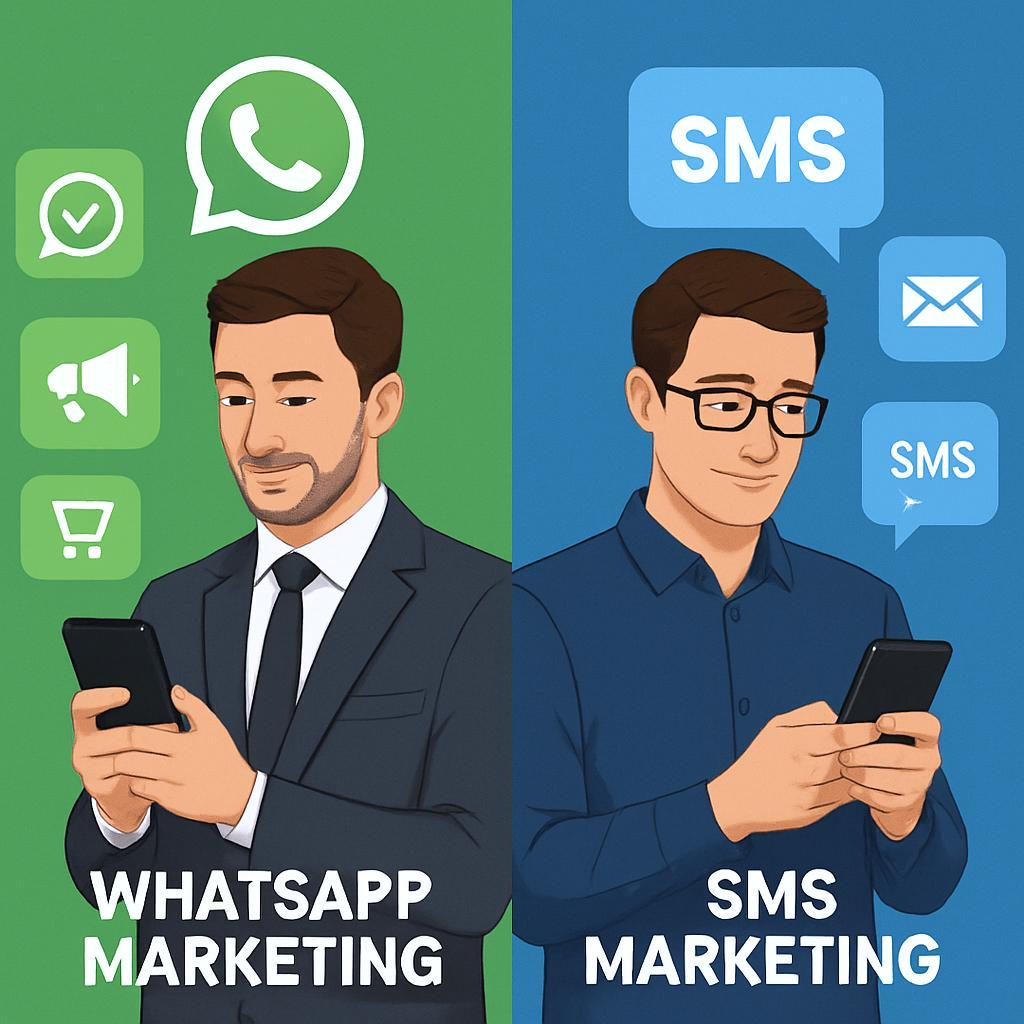How to Create a Well-Balanced Digital Marketing Strategy in the Age of AI
Read MoreBlogs > SMS Marketing 17-06-2025
Cracking Customer Engagement in KSA: WhatsApp vs SMS
Are you connecting with your Saudi customers in the right way?
In a market that’s digital-first and constantly online, the way you reach out matters more than ever. If you’re torn between WhatsApp marketing and SMS marketing in KSA, you’re not alone. Both channels dominate communication in the Kingdom—but which one actually drives results?
Let’s explore the battle of the inbox and see which channel truly cracks customer engagement in the Kingdom of Saudi Arabia.

The Digital Pulse of KSA: Why Engagement Is a Moving Target
Saudi Arabia leads the world in smartphone adoption since more than 97% of its citizens own smartphones. The audience size demands instant messaging and mobile-first communication because these practices have evolved into cultural norms.
- WhatsApp is the most-used messaging platform in KSA
- SMS remains highly trusted, especially in banking, healthcare, and government
WhatsApp Marketing: The Always-On Powerhouse
The marketing strategy of WhatsApp uses the daily app usage of more than 26 million Saudi people. The platform provides personal and instant conversational features which make it suitable for brands that want to establish relationships with their customers.
Benefits of WhatsApp Marketing in KSA:
- Two-Way Engagement
- Rich Media Options
- Higher Open Rates
- Brand Verification
- Customer Support Integration
Use Cases That Work:
- Flash sales & limited-time offers
- Abandoned cart reminders
- Customer service and FAQs
- Event invites and reminders
Pro Tip: Personalisation is everything. Use first names, shopping history, or location-specific offers to boost engagement.
SMS Marketing: Old but Gold?
While SMS marketing might feel old-school, in the KSA market, it’s far from dead.
Strengths of SMS Marketing:
- Ubiquitous Reach
- Trusted Channel
- Quick Delivery
- Wide Compatibility
Limitations:
- Character restrictions (160 per message)
- No visuals or media
- No conversation flow—one-sided messaging
- Lacks brand visibility or personalisation
WhatsApp vs SMS: Which Should You Choose?
| Feature | WhatsApp Marketing | SMS Marketing |
|---|---|---|
| Open Rate | ~98% | ~90% |
| Engagement | Two-way, real-time | One-way, limited |
| Media Support | Yes (images, links, video) | No |
| Personalisation | High | Low |
| Setup & Cost | Requires setup/API access | Easy to launch |
| Trust in KSA | High | Very High |
When to Use WhatsApp Marketing vs SMS Marketing
Choose WhatsApp Marketing when:
- You want a deeper connection or dialogue with customers
- You’re sending media-rich updates
- You aim to offer live support or chat-based sales
Choose SMS Marketing when:
- You’re sending alerts, OTPs, or system notifications
- Your audience includes non-smartphone users
- You’re running a quick, one-way campaign
Integrated Strategy: Best of Both Worlds
At Wisoft Solutions, we’ve helped businesses in Riyadh and beyond blend both channels for maximum impact.
Here’s how a smart omnichannel approach looks like:
- Use SMS for initial alerts (e.g. “New offer available”)
- Redirect users to WhatsApp for full details, images, and conversation
- Sync both into your CRM and retargeting campaigns
- Automate responses with WhatsApp bots for lead qualification
Cultural Preferences in Saudi Arabia: How They Impact Messaging Choices
- Saudi consumers value trust, privacy, and formal tone—WhatsApp Business with a verified badge builds credibility.
- SMS is still respected for its official tone, often used by banks and government agencies.
- Use Arabic-first content, especially in WhatsApp voice notes or SMS, to boost relatability.
WhatsApp Business API vs WhatsApp Business App – What's Best for You?
The choice between WhatsApp Business API and WhatsApp Business App depends on your specific business needs:
- WhatsApp Business App: Simple, manual, best for small businesses.
- WhatsApp Business API: Scalable, integrates with CRM, offers automation.
Need help setting it up? Wisoft Solutions provides complete support to establish both versions in a strategic manner.
KPIs to Track for WhatsApp & SMS Campaigns
Tracking metrics is key to proving ROI.
WhatsApp KPIs:
- Read rate
- Click-throughs
- Response time
- Conversion from click-to-chat
SMS KPIs:
- Delivery rate
- CTR
- Bounce rate
- Opt-out rate
Want to evaluate your campaign performance? Let Wisoft Solutions run an audit.
Compliance and Privacy in the KSA Market
- Always get explicit user consent before sending WhatsApp or SMS marketing messages.
- Respect opt-out preferences.
- Use official APIs to avoid bans or spam flags.
- At Wisoft Solutions, we implement compliant, secure messaging flows to protect your brand.
Conversations Over Broadcasts
In KSA, customer engagement is shifting. People expect value, speed, and personalisation. The transactional nature of SMS marketing remains strong, but WhatsApp marketing has emerged as the preferred choice for brands who seek to establish authentic dialogues with their customers. The full-service creative and digital agency Wisoft Solutions in Riyadh assists businesses to develop multi-channel strategies which connect with their audience. Our agency provides businesses with the necessary tools, technical expertise, and skilled talent to execute WhatsApp marketing strategies and SMS optimization—and their combination.
Let’s talk customer engagement—on your terms.
Frequently Asked Questions
Is WhatsApp marketing legal in Saudi Arabia?
Yes. With proper consent and usage of the official API, WhatsApp marketing is legal and effective in KSA.
Can I use WhatsApp and SMS marketing together?
Absolutely. SMS can drive initial attention; WhatsApp can handle deeper engagement.
Is SMS still effective for marketing in 2025?
Yes, especially for transactional use cases like OTPs and appointment alerts.
What’s the best platform to manage both WhatsApp and SMS?
Platforms with CRM and automation capabilities—Wisoft Solutions can help you choose and integrate one.
How can I grow my WhatsApp contact list?
Use opt-in forms, checkout opt-ins, QR codes, and incentives to collect user permissions.






